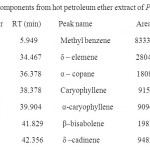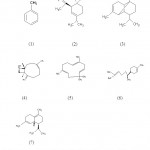Phytochemical Analysis of Hot Petroleum ether Extracts of Piper nigrum
Aditi Gupta1 * , Monika Gupta1 and Sudhakar Gupta1
1
Department of Chemistry,
Lovely Professional University,
Phagwara,
144 806
Punjab
India
DOI: http://dx.doi.org/10.12944/CWE.8.1.18
Copy the following to cite this article:
Gupta A, Gupta M, Gupta S. Phytochemical Analysis of Hot Petroleum ether Extracts of Piper nigrum. Curr World Environ 2013;8(1) DOI:http://dx.doi.org/10.12944/CWE.8.1.18
Copy the following to cite this URL:
Gupta A, Gupta M, Gupta S. Phytochemical Analysis of Hot Petroleum ether Extracts of Piper nigrum. Curr World Environ 2012;8(1). Curr World Environ 2013;8(1). Available from: http://www.cwejournal.org/?p=3214
Download article (pdf)
Citation Manager
Publish History
Select type of program for download
| Endnote EndNote format (Mac & Win) | |
| Reference Manager Ris format (Win only) | |
| Procite Ris format (Win only) | |
| Medlars Format | |
| RefWorks Format RefWorks format (Mac & Win) | |
| BibTex Format BibTex format (Mac & Win) |
Article Publishing History
| Received: | 2013-03-07 |
|---|---|
| Accepted: | 2013-03-20 |
Piper nigrum, belong to family piperaceae is a monoecious, perennial climbing herb, native of Southern India and Srilanka, cultivated in tropical regions.1 It is found in vast altitudinal diversity and shows great adaptability to a wide range of climatic and soil conditions which leads to interspecies diversity.2 Various pharmacological activities such as antimicrobial,3 analgesic, antipyretic, anti-inflammatory, anticonvulsant, CNS depressant,4 antimutagenic,5 antioxidant and radical scavanging,6 antiinsecticidal,7 synergist,8 allelopathic9 and antirheumatism1 have been reported. It is found to be helpful in reducing pain, chills, flu, colds, feverand muscular aches.1 The dried fruits act as a source of medicine for aphrodisiac, carminative, antiseptic, diuretic, galactagogic and emmenagogic.11 The aromatic fruits are used as spices and unripe fruit is a source of black pepper.10 It has many physiological activities and therefore is of high commercial, economic and medicinal importance.12 During our research for novel bioactive natural products, the seeds of the plant are soxhalated with various organic solvents. All the extracts were showing the potential for further treatment. The petroleum ether extract after keeping untouched for twenty days, separated into thick lower solid portion and upper oily fraction. The oily fraction obtained from the petroleum ether extract on GC-MS analysis showed the presence of seven different components.
Materials and Methods
Seeds of Piper nigrum were purchased from the specific seed shop at Jammu district and identified by Dr. Gurdev Singh of Botany department at Lovely Professional University. Dried and crushed seeds (1 Kg) of Piper nigrum were soxhalated in ethanol for around 72 hours. The ethanol extract was than distilled with light petroleum ether, toluene, chloroform and ethyl acetate according to their polarity gradients. The oily fraction of petroleum ether extract was subjected to GC-MS for identification of different components present in it.
 |
Table 1: Different components from hot petroleum ether extract of Piper nigrum Click here to View table |
Analysis of Oily Fraction
The GC-MS spectra of oily fraction of hot petroleum ether extracts of Piper nigrum recorded from Varian 4000 GC-MS/MS unveiled the presence of following components:
Among these chemical constituents methyl benzene is present as major component and δ – elemene as minor component, structures are given below
 |
Figure 1: Various components from hot Petroleum ether extracts of Piper nigrum Click here to View figure |
Acknowledgement
The author is thankful to IIIM Jammu for GC-MS and Lovely Professional University for its lab facilities.
References
- Reshmi S.K., Sathya E. and Devi P.S., J. of Medicinal Plants Research., 4(15), 1535-1546, 2010 .
- Parthasarathy U., Asish G.R., Zachariah T.J., Saji K.V., George J.K., Jayarajan K., Mathew P.A. and Parthasarathy V.A., Current Science., 94(12), 1632-1635, 2008.
- Dorman H.J.D. and Deans S.G., J.of Applied Microbiology, 88(2), 308-316, 2000.
- Madhavi B.B., Nath A.R., Banji D., Madhu M.N., Ramalingam R. and Swetha D., Int. J. of Pharmacy and Pharmaceutical Sciences., 1(2), 156-161, 2009.
- El H.R., Idaomar M., Alonso-Morago A., Munoz S.A., Food chem.. Toxicol., 41(1), 41-47, 2003, http://dx.doi.org/10.1016/S0278-6915(02)00216-8
- Gulcin I., Int . J . Food Sci.Nutr., 56(7), 491-499, 2005, http://dx.doi.org/10.1080/09637480500450248
- CFSu. Helen. and Horvat R., J. Agric. Food Chem.,29(1) , 115-118, 1981, http://dx.doi.org/10.1021/jf00103a029
- Scott I.M., Jensen H.R., Philogene B.J.R. and Arnason J.T., Phytochemistry Reviews ., 7(1), 65-75, 2008, http://dx.doi.org/10.1007/s11101-006-9058-5
- Siddiqui Z.S., Acta Physiologiae Plantarum., 29(4), 303-308, 2007, http://dx.doi.org/10.1007/s11738-007-0039-0
- Francois T., Michael J.D.P., Lambert S.M., Ndefor F., Vyry W.N.A., Henri A.Z.P. and Chantal M., African J. of Biotechnology., 8(3), 424-431, 2009.
- Gadir W.S.A., Mohamed F. and Bakhiet A.O., Research J. of Microbiology., 2(1), 824-830, 2007.
- Siddiqui B.S., Gulzar T., Begum S., Afshan F. and Sattar F.A., Natural Product Research., 19(2), 143-150, 2005, http://dx.doi.org/10.1080/14786410410001704750






